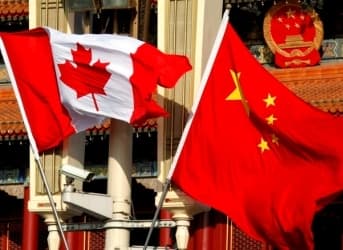Given that the Keystone XL pipeline is apparently dead in the water at least until after the next presidential election, Canada is seeking new export markets in Asia for its booming oil and natural gas production.
Few Americans realize it, but according to the U.S. Energy Administration, the United States total crude oil imports now average 9.033 million barrels per day (mbpd), with Canada sending 2.666 mbpd southwards to the U.S., making it America’s top source of oil imports. In 1988, Canada and the United States signed a free trade agreement that was supposed to ensure Canada would never prevent the U.S. from having first access to its huge oil reserves and bilateral trade is now worth $750 billion annually, with annual Canadian imports of U.S. goods now worth yearly than those taken by the BRICS (Brazil, Russia, India, and China) South Africa, Germany, and Great Britain combined.
But now, the Conservative government of Prime Minister Stephen Harper, stung by the Keystone XL pipeline debacle, is looking westwards for future energy production exports, particularly to China. Harper has made this shift in priorities explicit, on 2 April at the Woodrow Wilson International Center for Scholars in Washington D.C., "We cannot be in a situation where really our one and only energy partner can say no to our energy products. The very fact that a no can be said underscores to our country that we must diversify our energy export markets."
Harper’s observations were hardly off the cuff remarks, as in February he told 600 Chinese and Canadian business leaders in Guangzhou that Canada and China are about to enter a new era in a strategic energy partnership, while warning Washington that if it does not want Canadian oil, his government would be happy to sell it to China. Harper told his audience, "We are an emerging energy superpower. We have abundant supplies of virtually every form of energy. And you know, we want to sell our energy to people who want to buy our energy. It's that simple," he said, to applause from the crowd.
So, what’s on the drawing boards to replace Keystone XL?
First, the $5.54 billion, 731-mile Northern Gateway pipeline, proposed by Enridge Inc., which would carry 525,000 barrels a day (bpd) of Alberta's oil sands to a supertanker port in Kitimat, British Columbia.
But opposition to the pipeline has swiftly mounted, led by Canada’s Indian community. The proposed pipeline route crosses land owned and claimed by Indian tribes and nations who worry that the pipeline will leak and foul rivers that are important salmon spawning grounds, while Indian groups in British Colombia argue that the coastline is too rugged for supertankers and that an oil spill is inevitable.
The solution? Enbridge company is offering the Indian tribes about $1 billion dollars for "community building" and a 10 percent share in the project if they drop their opposition, while Harper’s government said that it will force time limits on regulators reviewing the pipeline plan, as it wants Northern Gateway approved within two years, despite opposition by Indians as well as Canadian and U.S. environmentalists.
Nor is Northern Gateway the only energy transit project in the works, as on 10 April the British Colombia Environmental Assessment Office approved increasing the carrying capacity by 36 percent of the proposed $1 billion Pacific Trails natural gas pipeline. Pacific Trails is designed to transport natural gas from northeast British Colombia to Kitimat for export overseas. The pipeline project is owned by a consortium of EOG Resources, Apache and Encana, which also owns the $4.5 billion liquefied natural gas plant proposed for Kitimat.
Indigenous opposition should not be discounted, as the Northern Gateway pipeline would pass through the territory of indigenous communities including the Carrier-Sekani Tribal Council, the Haida Nation, and the Yinka Dene Alliance, many of which have not signed treaties with the Canadian government, giving them heavy leverage in Ottawa to stop or significantly delay the pipeline because their land has not been ceded to the federal government. And 130 communities are strongly opposing the pipeline and tanker project, signing the Save the Fraser Declaration and the Coastal First Nation Declaration. Indigenous communities whose territories make up more than 50 percent of the combined pipeline and tanker route do not support this project and up to now have banned oil tankers and pipelines using their indigenous laws and authority, which are recognized under Canadian and international law, vowing to “form an unbroken wall of opposition from the U.S. border to the Arctic Ocean.”
ADVERTISEMENT
So, which will prevail, Enbridge’s bribes and the Harper government’s rewriting of legislation, or Indian and environmental opposition? Energy companies have already invested more than $96 billion developing Alberta’s oil sands, so the issue is certain not to go down without a massive slugfest.
By. John C.K. Daly of Oilprice.com



















Wyoming and ND will get tied and produce lots, lots of oil.
To the USAs ...to the World's benefit.
The sands are recycled, with topsoil replaced, and reforested, so no need.The sands are removed BEFORE entering any pipeline, just heavy crude mixed with diluent. Also,refiners are EXPENSIVE to build, with little demand for refined products.No pipeline to ship East to the Great Lakes. Hullo?
The XL will be built, at some point. Right now the U.S, is getting a 30$/bbl discount. THAT will disappear, when China, Japan start buying after Gateway P L nad TM exp done. Look for higher prices. What goes around comes around.